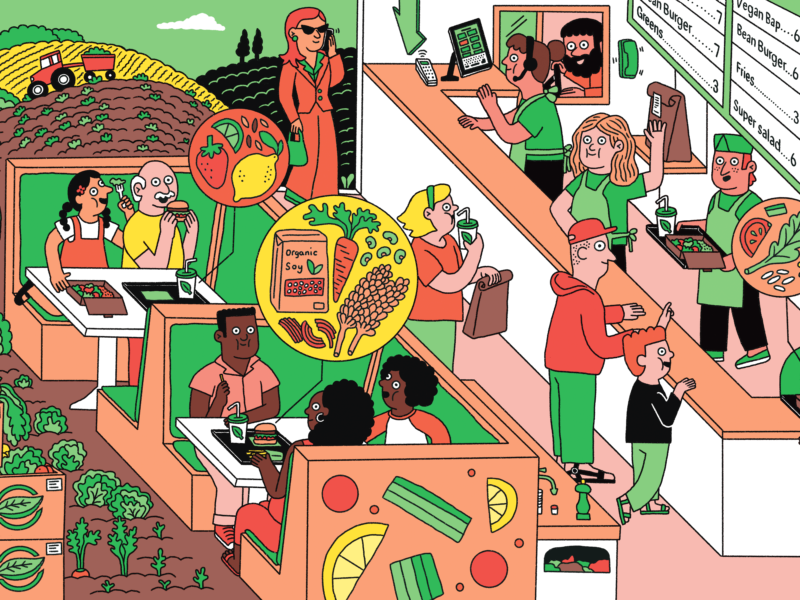Despite the father’s documented history of abusive behavior, the judge presiding over a shared parenting dispute saw no urgent need to re-evaluate the arrangements.
On February 9, 2020, Robin Brown took his four-year-old daughter Keira hiking at Rattlesnake Point Conservation Area in Milton, Ontario. Later that day, police found their bodies at the bottom of a cliff; they suspect that Brown took the little girl in his arms and jumped off a bridge.
Keira’s mother, Jennifer Kagan, and her husband Philip Viater, are convinced it was a murder-suicide, triggered, in part, by a court ruling that retracted her former husband’s right to unsupervised visits with his daughter. Kagan had recently requested an emergency hearing on January 28 to suspend access; they were due in court on February 20.
Keira, who leaves behind a mother, stepfather, and baby brother, was at the centre of a long and contentious three-year shared parenting dispute for most of her short life. There was a long-standing and well-documented history of domestic abuse, including a horrifying incident with Brown trying to force a dead mouse into his then-wife’s mouth. There were also numerous examples of bullying, constant lying, and escalating erratic behaviour. While every judge warned Brown that he risked a ruling that would curtail his access to Keira, none made good on the threat. Even when a motion was brought on to suspend his access, the judge presiding over the case did not see the urgency. He said the abuse Brown had perpetrated against his former wife “was not relevant” to the visitation arrangements, and that he was “going to ignore it.” He added that he did not believe Keira’s safety was at risk.
Justice Douglas Gray had not practiced family law, but rather employment law. As strange as that might sound, this is not an anomaly in the justice system. Many judges hearing family law cases have no background at all in the field. Lacking experience and training, they often fail to recognize the warning signs.
Years of abuse and manipulation
Jennifer Kagan is a palliative care physician in Brampton, Ontario, a suburban town just outside Toronto. She fell in love with and married Robin Brown, an engineer, in 2013. Like all abuse cases, theirs did not begin as one.
“Robin could be extremely charming and agreeable if he wanted to be,” Kagan said. “It was only after we were married that the veil came off. By the time I was pregnant with Keira I was very afraid.”
Brown was prone to unpredictable and angry outbursts; Kagan found herself walking on eggshells around him.
“There was a real scariness in him that I had never seen before,” she said. “He was very controlling, very misogynistic. It wasn’t run-of-the-mill abuse. This man was a psychopath. I feel stupid in retrospect because I was so duped.”
Kagan was able to escape the abusive relationship and avoid becoming one more domestic violence statistic, but she was not able to escape her ex-husband’s control. Nor was she able to save her daughter. She followed all the appropriate legal channels and had the financial resources that many domestic abuse survivors do not, but she still hit a wall when it came to family law proceedings. Despite Brown’s well-documented pattern of abuse and lies, the courts awarded him shared parenting and thus the means to continue making Kagan’s life miserable. Brown had Keira on alternating weekends, including the weekend she was murdered.
When co-parenting becomes a way to extend the abuse
“Co-parenting was a way for him to continue to control me,” said Kagan. She said that he continually brought frivolous motions to court, forcing Kagan to pay for lawyers to appear before a judge, even as Brown was “constantly disobeying court orders or caught lying.”
Brown abducted Keira when she was just one year old, refusing to return her to Kagan unless she agreed to sign an agreement to rotate custody between their homes every 48 hours. Kagan was still breastfeeding Keira at the time; she refused to sign the agreement. The court stated that Brown’s having abducted Keira was not an urgent matter, but eventually returned her to Kagan’s care. At trial, Justice Gray ignored the abduction incident; he chastised Kagan for refusing to sign the 48-hour rotating custody agreement. If Kagan had withheld access to Keira from her ex-husband, she would have been subject to legal repercussions for failing to comply with their shared parenting arrangement.
Deeply worried about her daughter’s safety and increasingly desperate, Kagan brought forward an urgent motion on January 28, seeking a court order to suspend Brown’s access to Keira or limit him to supervised access. That, along with a review by the Jewish Family and Child Services that raised serious concerns about Brown, was apparently what triggered him to commit murder-suicide.
Shared parenting is prioritized over safety of women and children
Pamela Cross, a lawyer and expert on violence against women and the law, knows Jennifer Kagan’s case well. “Co-parenting and joint custody often just become another way for an abuser to control the abused,” she said, adding: “Exchanges of children can become extremely dangerous for abused women.”
Many of the issues stem from the fact that the family court system is premised on “friendly parenting.” It does not consider the prevalence of post-separation violence and tries to prioritize shared parenting over the safety of women and children.
“The system really failed Keira,” said Kagan. “She needed a voice and she didn’t get it. We need family law reform where the children’s needs are put first, and where they don’t end up as pawns in the system. Their rights should always supersede the parents’ rights.”
Understanding post-separation violence
Cross believes that lawyers, mediators, clerks and judges need to be trained in the dynamics of domestic violence. Right now, few understand that it continues after the divorce is finalized; nor do they realize the impact it has on the safety of both children and mothers. As a result, lawyers and judges in custody cases often label serious family violence “high-conflict”—instead of a dynamic that presented a serious power imbalance, with a highly elevated risk of harm.
Canada’s federal government is not currently considering mandatory training for judges. The government’s position is that since judges are independent, they have the the right to decide if they want to participate in training. The government has put forward a bill that would allow judges to consider domestic violence, including coercive control, as one factor in considering custody and access, but the wording of the suggested legislation does not offer the courts any guidance regarding the definition of domestic violence; nor does it require judges to undergo training that would help them understand the issue.
“Basically they have words on a piece of paper but no teeth behind it because if a judge does not understand the words, then they will ignore it like Gray,” says Philip Viater, Kagan’s husband, who is also a lawyer.
The bill would be an important first step, but Cross said it’s not enough. Because domestic violence cuts across many areas, such as criminal law, family law, wills and estates, and real estate law, lawyers and judges need to be trained in the entire range of resolution processes available for family disputes, as well as the dynamics of separation and divorce, particularly as they affect children and including issues of power and family violence.
Repeated history of coercive control is a red flag
“Many of the decisions I see reflect a lack of understanding of the complexities of family violence,” Cross says. “I don’t believe that a parent who has been abusive to their partner should never see their children again, but it needs to be acknowledged that co-parenting may not be possible if persistent abuse was documented.”
Cross wants people to understand there is an enormous difference between a high-conflict divorce where both parties are angry, hurt, and perhaps not on their best behaviour, and a divorce with an abusive partner where there is significant fear and no balance of power. In the latter, she said, “One person has been victimized and there is a long pattern of coercive control that often attempts to manifest itself through child arrangements or baseless accusations of parental alienation.”
A legal system that continues to minimize domestic violence
Melpa Kamateros is the Executive Director of Shield of Athena, a Montreal-based non-profit organization for victims of family violence that offers emergency shelter and professional services to women and their children.
“Custody cases can often become an extension of abuse through legal means,” said Kamateros, echoing Pamela Cross. The justice system is long and complicated for abused women, she added—particularly for those who are from ethnic minority backgrounds or recent immigrants; and for those who lack the money, social power, support, and education to fight back.
“Conjugal violence should be treated as a top priority, yet it rarely is. The onus is so often put on victims, which, essentially re-victimizes them, and parental alienation is used repeatedly as a tool by abusers.” Judges, Kamateros said, tend to view domestic violence “as an aggravated factor in divorce cases,” rather than violence per se.
Making the legal system work more effectively for victims
The legal system, which is instrumental in shaping social policy, has been slow to recognize the impact of domestic violence on children. Changes to legislation in criminal, civil, and federal law can often face resistance because they challenge patriarchal structures, touching on issues of marriage, family, and gender norms that are deeply embedded in political and legal institutions.
The legal system has often failed to examine the effects of domestic violence on children when it comes to child custody and visitation, restraining orders, protecting a child from harm, and termination of parental rights.
Kamateros said the legal system also needs to ensure that legal aids and lawyers are trained in conjugal violence, since women without financial resources cannot afford to hire a lawyer who specializes in family law. Legal aid practitioners, she said, “are often not trained or sensitive to the realities of conjugal violence.”
Kagan’s case, of course, demonstrates that even for women who do have the resources to pay a lawyer who specializes in family law, there are no guarantees of a positive outcome. The judge trying the case might not have any specialized knowledge or awareness of domestic violence.
A domestic abuse bill is needed
Britain is leading the way in overhauling its family court system with the Domestic Abuse Bill. The government initiated the bill following the publication of an expert-led review, which showed that between 2014-19 four children had been killed by a parent who had a history of abuse, and to whom access had been awarded by a court.
The reforms will allocate more powers for judges to prevent abusers repeatedly dragging former partners back to court and re-traumatizing victims. It will also push through more education and training for family court professionals, with the goal of prioritizing the safety of the victim and the child. The bill is now at the report stage and being debated in the House of Commons. It’s an important step for the U.K. and one that is desperately needed in Canada.
“I have no doubt that Keira’s death could have been prevented,” said Kagan. “There was no justice for her. She deserved so much and got so little. It makes me so angry and I don’t know where to go with this anger. At this point there’s nothing left for me to do but honour her legacy by helping enact desperately needed change. I know there are other Keiras out there.”



